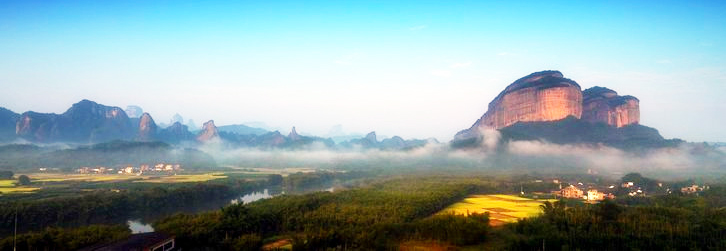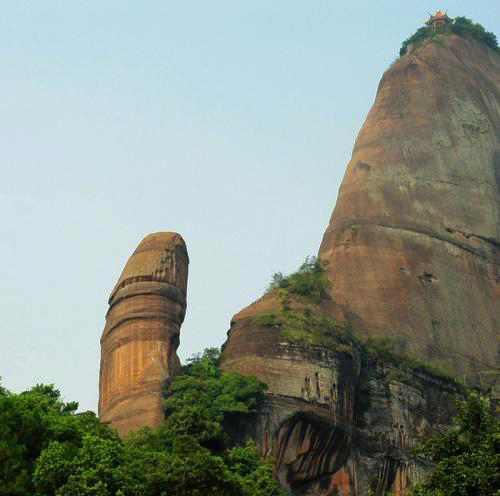
Rising out of the lush greenery of northern Guangdong province like a series of oddly shaped columns, the rock formations of Mount Danxia are as bizarre as they are marvellous. In fact, the mountain range’s appearance is so unusual that it even gave rise to a new geological term: the Danxia Landform. Although Danxia Landforms can be found throughout the country, they are unique to China. They are formed of red sandstone and other minerals, which have been deposited by rivers over a period of about 24 million years. These deposits settled into distinct layers and, after another 15 million years, faults in the earth created by tectonic plate movement caused them to become exposed. Over another few millions of years, they were moulded into strange shapes by weathering and erosion, resulting in the rocky outcrops that we find today.
In 2010, along with a host of other Danxia Landforms, Mount Danxia was listed by UNESCO as a World Heritage Site under the collective title “China Danxia”. The region itself benefits from a subtropical climate and is blessed with frequent rainfall, so the mountains are blanketed in thick forests containing several rare tree and plant species. Among these, there are twenty-eight ancient trees that are over one hundred years old, and fourteen that have survived for more than three centuries. After such a long time, these trees give new meaning to the term evergreen!
The Mount Danxia Scenic Area is made up of over 680 various rock formations, including stone peaks, walls, pillars, and even bridges. Set against the azure sky, with jade waters trickled at their base and grassy outcrops clinging to their façade, they form a picturesque tableau in the tranquil countryside of Guangdong. Visitors can take a relaxing boat ride down the Jin River and marvel at the mountains from below, or choose to tackle them head-on. The main peak only rises to approximately 410 metres (1,340 ft.), making for a rewarding but leisurely hike.

Alongside the main columns of the mountain range, the scenic area incorporates a myriad of peculiar attractions, including: the Yangyuan or “Male/Father Stone”, which is so-named because of its startling resemblance to a phallus; the Yinyuan or “Female/Mother Stone”, which faces and complements its masculine neighbour; and the Breast Stones, a pair of round rocky ledges protruding from a cliff-face above the ground. Evidently whoever named these stone formations had only one thing on their mind!
Like many other mountains across China, Mount Danxia has been an important Buddhist site since the Sui Dynasty (581-618) and features a number of temples, including Biezhuan Temple on Zhanglao Peak. Countless cliff tombs and cliff coffins can also be found throughout the scenic area, some of them dating back over a thousand years. Yet it is the plethora of poems, carvings, and inscriptions left behind by historic writers and painters that attest to Mount Danxia’s enduring popularity. They act as proof that, no matter the era, this mountain range will continue to inspire awe in its visitors for centuries to come.